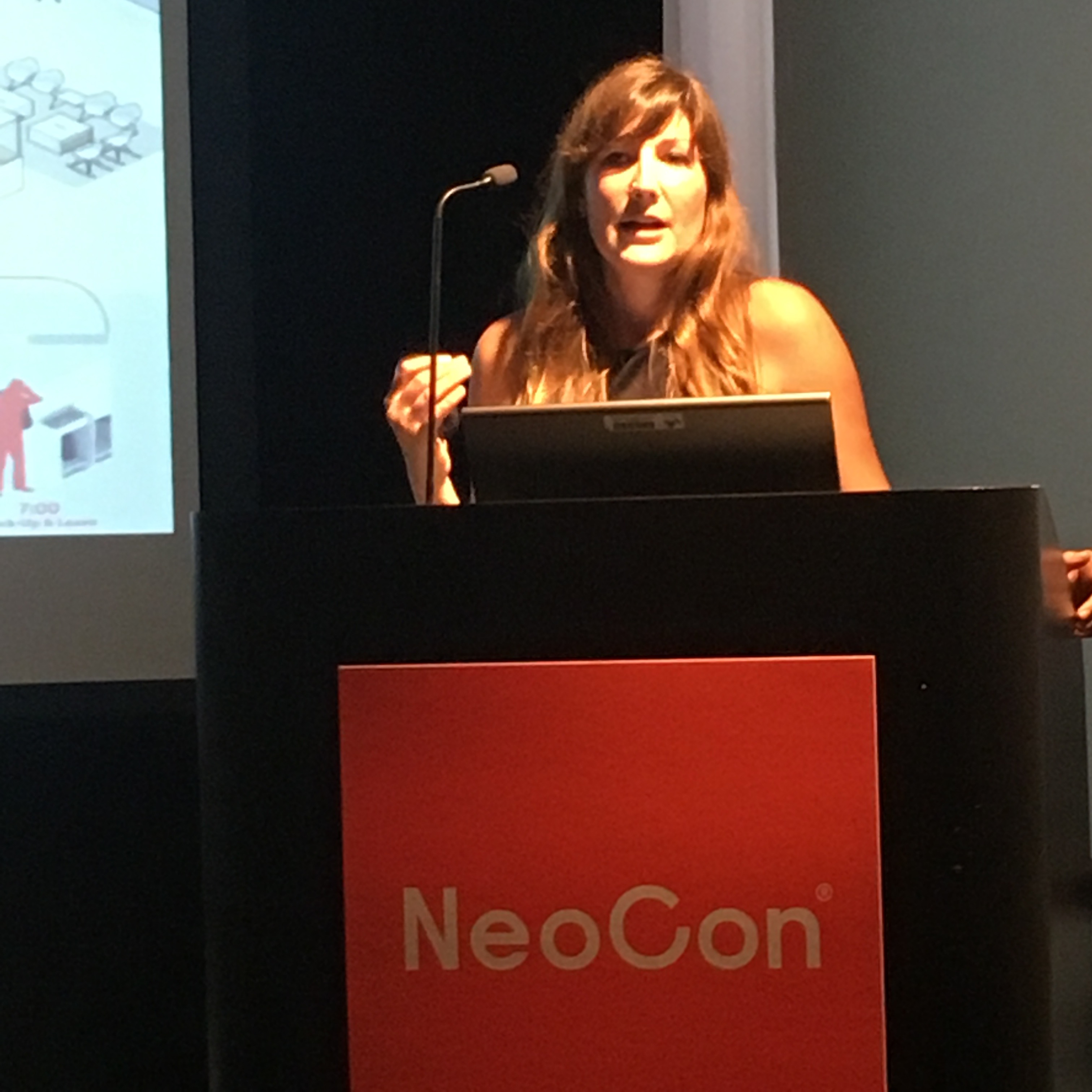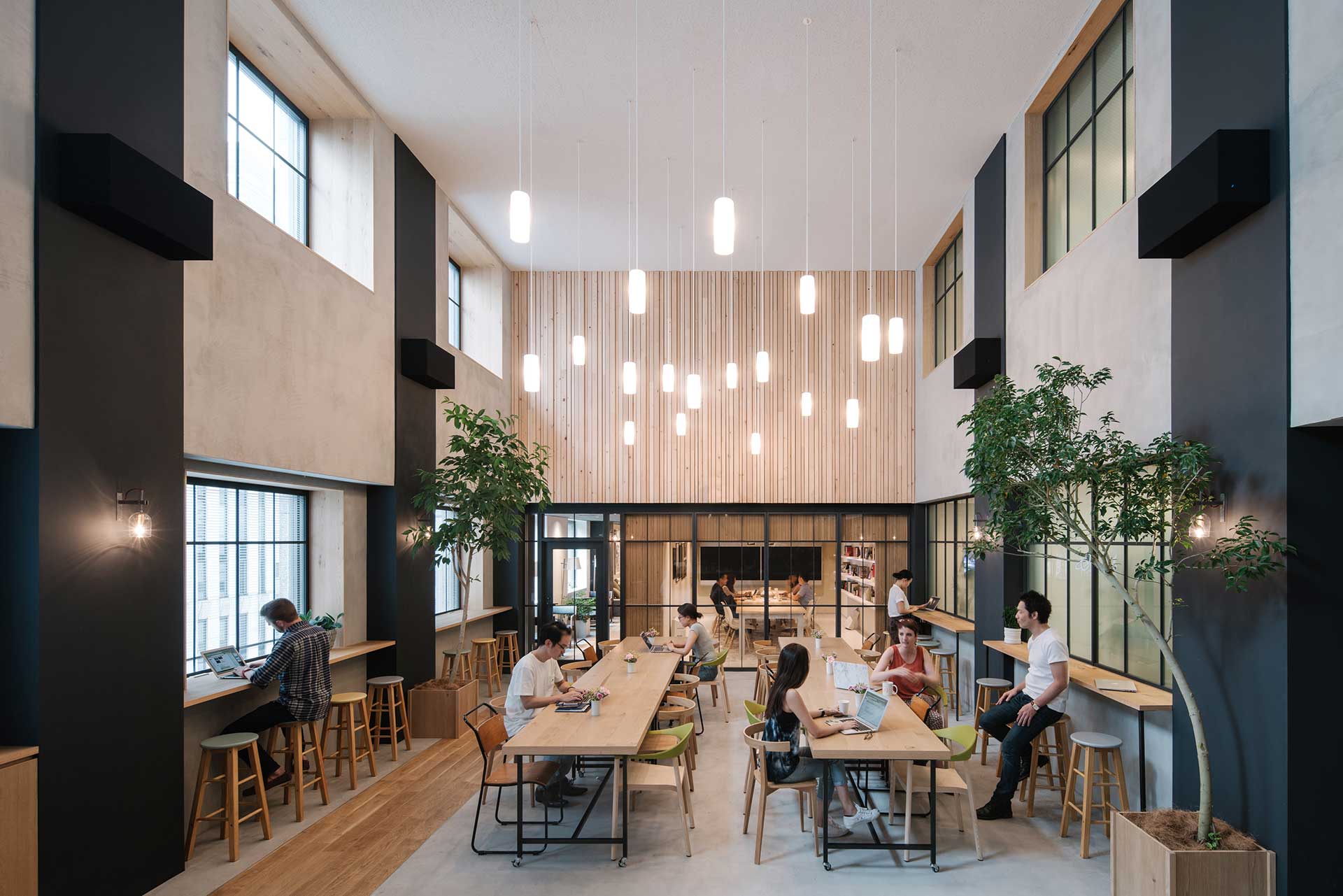How Airbnb Approaches Office Design Around the Globe
The company, which has more than 25 international locations, will continue its worldwide expansion. Here's an insider's look at its office spaces.
By Diana Mosher
The Airbnb story started in 2007 during a weekend when hotels in San Francisco were sold out for a design conference. Seeing an opportunity to make rent money, Brian Chesky and Joe Gebbia hosted the first guests of airbenandbreakfast.com in their apartment on Rausch Street. In 2008, Chesky and Gebbia partnered with Nate Blecharczyk to found the Airbnb brand. The company has since grown from just one home in one country in that one city to more than 5 million homes in 191 countries—including nearly 3,000 castles and 1,400 treehouses.

Rebecca Ruggles shared Airbnb’s global office design strategy at NeoCon 2018. Photo by Diana Mosher
Airbnb leverages technology to empower millions of people around the world to unlock and monetize their spaces, passions and talents to become hospitality entrepreneurs. But not all business is conducted in cyberspace. In fact, Airbnb has more than 25 international offices and it will continue to grow this global presence. Workplace design plays an important role in keeping employees engaged. Rebecca Ruggles, NCIDQ, lead interior designer, Airbnb in San Francisco shared insights into corporate design initiatives during an educational session at NeoCon 2018.
“Our founders had the foresight to create an in-house design studio called Environments. We are a small but mighty team based in San Francisco and made up of trained architects and interior architects,” said Ruggles. “We come up with concepts and schematic designs, and we also partner with local architects to render and complete the work. It’s a very hands on process that we’ve now completed for over 12 offices in 10 different countries over the last four years.”
Back to the office
Like other companies, Airbnb wants to draw its employees back to the office because that’s where the magic happens through conversation and sharing new ideas. Some edgy employers are luring people back with fun elements like a slide that leads into a pit full of stuffed animals. “For us, it needs to be rooted in our business,” said Ruggles.
Airbnb’s offices are designed to create culturally sensitive standards that also adhere to the organization’s global and corporate functionality standards. The challenge in a connected, global culture is how to preserve and celebrate what makes us unique, but still bring people together and help them bond over common corporate culture.
“When you walk in, you [have to] know where you are even without a logo on the door,” added Ruggles. It’s similar to the experience of Airbnb guests who can travel anywhere in the world, drop in and feel like they are a part of that place. “You feel welcome. You should never feel like a stranger. Airbnb’s mission is to belong everywhere in the world, and this is a big crux of everything we do including how we approach office design,” she said.
Around the world
Airbnb brings the strategy of sharing space into its “belong anywhere office” by reducing the size of the desk and setting up a variety of zones that employees self select throughout the day depending on the work they are doing. “We don’t tell people where they work; instead we create cultural moments,” explained Ruggles. “We celebrate our hosts and employees [from all over the world] with graphics on the wall. We also created an abstract version of a canal boat with private workspaces called ‘duck ins.’ We highlight our listings in our meeting rooms which are themed from actual homes around the world.”
In the Beiing office, for example, employees can travel to an Airbnb home in Santorini, Greece. A plaque identifies the name of the home that has been recreated and its location. It’s a great way for employees to physically connect with the Airbnb product. At the same time, the local culture and employee preferences are researched before an office is designed.
See how the Airbnb team in Dublin, Ireland likes to work in this office designed in collaboration with heneghan peng architects.
“In Paris, not surprisingly, research revealed that employees are foodies. It’s a small team. They love to cook and eat together on a daily basis,” said Ruggles. They have a very familial atmosphere; at times they even cook dinner together.
The new office space designed in collaboration with STUDIOS Architecture is built around three design principles: the office feels like a Parisian loft, the kitchen is the heart of the space and the aesthetic incorporates a vintage flea market vibe. Evoking the comfortable aesthetic of an attic apartment, the casual atmosphere matches the needs of the employees who prefer working in a lounge on a sofa with the laptops.
On the other side of the world in the Beijing office, employees definitely prefer working at desks rather than in a cafe or lounge setting. Research also gleaned that the local Airbnb employees are very proud of their city’s ancient architecture. A series of maze-like alleyways that connect historical homes are punctuated by large courtyards for community gatherings. This information informed the layout of the office with a “layered” approach to space configuration that encourages discovery. “As you get deeper into the space, you start to find new things and find new people along the way,” said Ruggles.
In answer to employees’ concerns about Beijing’s air pollution issues, the new Airbnb office has lots of plants and the best possible HVAC and air filtration systems thanks to LEED Gold certification. “Also we learned a lot about the Cardinal School of Feng Shui,” said Ruggles. China is a growing market for Airbnb, and since Beijing is a tech-focused city—much like San Francisco—this office is being used as a recruiting tool for a great number of local engineers.

Designed with local architect Suppose Design, Airbnb’s Tokyo office incorporates feedback from local Airbnb employees. Photo courtesy of Airbnb
One of the key elements at the new Tokyo office is the “Engawa,” an elevated platform covered with Tatami mats inspired by traditional Japanese culture where employees can remove their shoes, take a seat and enjoy the spectacular view of Shinjuku. Tea house phone booths are another architectural element of the office. They are made from local white oak and rice paper film to emulate the soft glow of Japanese tea houses. Partnering with local architect Suppose Design—and absorbing feedback from the Airbnb Tokyo employees—has resulted in a workplace design with an authentic sense of place.






You must be logged in to post a comment.